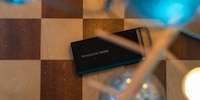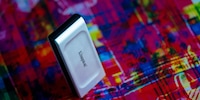

Samsung T7 Touch: Looks cool, is cool and is also fast
Samsung continues the T series of portable SSDs with the T7 Touch. Thanks to USB 3.2 Gen 2, high read and write rates are possible. Compared to the predecessor T5, there is a fingerprint scanner and a special cooling solution.
The T5 is also fast. The T7 is damn fast thanks to PCI Express. SATA technology is a bottleneck for the T5: the transfer rate of USB 3.1 Gen 2 at 10 Gbit/s is higher than that of SATA at 6 Gbit/s. In terms of sequential reading, the T7 is theoretically twice as fast as the T5, which is limited to 540 MB/s.
| T7 Touch | T5 | |
|---|---|---|
| Format | NVMe | mSATA |
| Size (l×w×h) | 85×8×57 mm | 74×10.5×57.3 |
| Weight | 58 grammes | 51 grammes |
| Interface | USB 3.2 Gen 2 | USB 3.1 Gen 2 |
| Maximum transfer rate | 1050 MB/s | 540 MB/s |
| NAND flash | 3D V-NAND (TLC) | 3D V-NAND (TLC) |

Fast, faster, T7
To compare the T7 Touch with the T5 - always in the 1 TB version, by the way - I run various benchmarks. I monitor the temperature of the SSDs with Crystal Disk Info. The tool also gives me information about the health of the drives, the interface and the transfer mode. Here I can also see that the T7 is running with NVMe in version 1.3.
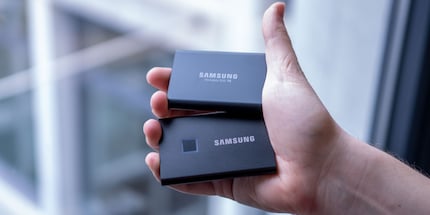
The ATTO Disk Benchmark tests the read and write performance of various transfer sizes from 512 B to 64 MB. The read and write performance specifications of many manufacturers are based on this test methodology because it delivers the best measurement results.
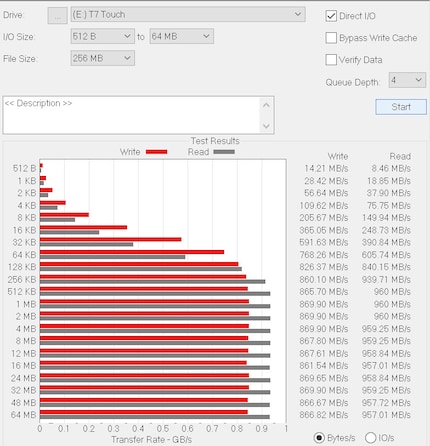
The T7 Touch is faster than the T5 when reading through the tape. When writing, the T5 is faster for very small files. From 64 KB, however, the T7 is faster again. It is around 127 per cent faster when reading and around 77 per cent faster when writing.
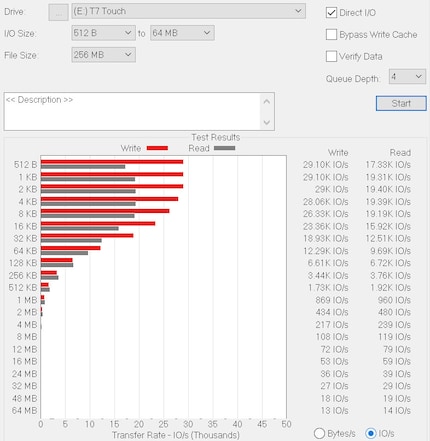
The T7 also tends to be faster than the T5 in terms of IOPS. This is the case across the board when reading. When writing very small files, the T5 is again faster. From 512 KB, the T7 is again ahead.
In addition to read and write speeds and IOPS, the benchmark from Anvil's Storage Utilities also shows response times. This shows that the T5 has shorter read response times. The T7 responds faster when writing.
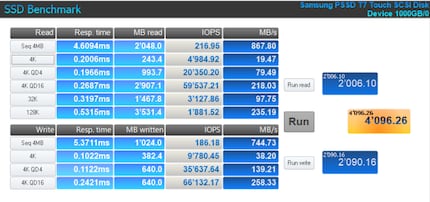
Cool, cooler, T7
Samsung relies on encapsulated phase change materials (ePCM) for cooling. These are designed to absorb and gradually release heat. This seems to work perfectly with the T7. When I copy the Steam benchmark game library - 493 GB - to the T7, the maximum temperature is 47° Celsius. The data is initially transferred at 550 MB/s. After about 39 GB of transferred data - the cache is most likely exhausted here - the speed stabilises at around 450 MB/s. On the surface, the temperatures differ only slightly, as an image taken with our thermal imaging camera shows.
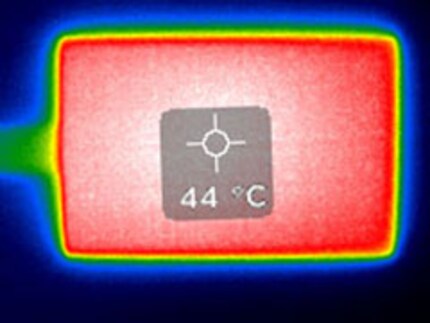
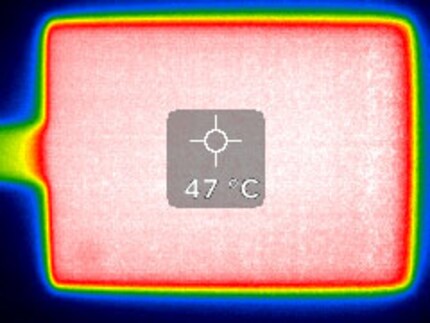
With the T5, it is noticeable that it runs significantly hotter than the T7. It gets up to 67° warm inside. From 67°, the transfer speed drops continuously from originally around 400 MB/s to an average of 250 MB/s. Surprising, as NAND flash should actually not have a problem up to 70°. The controller probably gets too hot. The SSD reaches 67° after about 6:30 minutes. The transfer speed then begins to drop and after a further nine minutes it stabilises at around 250 MB/s.
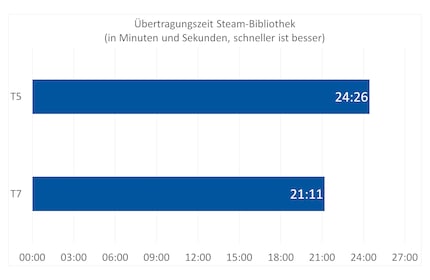
Finally, I transfer a folder with photo RAW files to test a real-life scenario. Who transfers almost 500 GB at once? The folder is 3.75 GB in size.
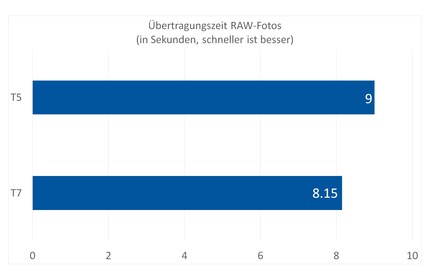
Safe, safer, T7?
With the T7, you can also secure your data with a fingerprint. Like password protection, this is optional, but easier because you don't always have to type in your password. However, even this does not protect you 100 per cent from unauthorised access to your data, as a fingerprint can also be forged. The fingerprint is stored on the sensor and not the NAND. The AES-256-based encryption is activated and deactivated via the Samsung Portable SSD software. You can also use the software to install firmware updates.
Simple, sleeker, T7
Although the T7 Touch is over a centimetre longer than the T5, it looks less bulky. This is because it is 2.5 millimetres thinner at 8 millimetres. Apart from the dimensions, the only difference in the design is the fingerprint scanner on the top. This is surrounded by a blue LED strip that provides information about the status of the external SDD.
Conclusion: Fast, cool, secure and simple
I already use a T5 to shovel data back and forth. I like the design and speed of the external SSD. It's also very robust. The T7 Touch takes all the good things about the T5 and improves on them in key areas.
In everyday use, most users won't really notice the difference in speed. With the 3.75 GB RAW photos, the transfer to the T5 only took a little more than a second longer than to the T7. If you already own a T5, you don't need to buy a T7 Touch - unless you have to, because you always have to have everything new.
From big data to big brother, Cyborgs to Sci-Fi. All aspects of technology and society fascinate me.

